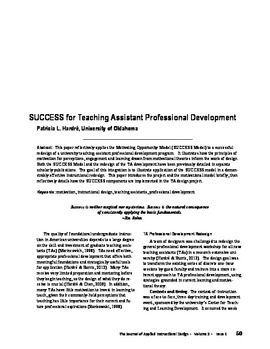| dc.contributor.author | Hardre, Patricia | |
| dc.date.accessioned | 2016-06-03T19:36:30Z | |
| dc.date.available | 2016-06-03T19:36:30Z | |
| dc.date.issued | 2012-07 | |
| dc.identifier.citation | Hardré, P. L. (2012). SUCCESS for Teaching Assistant Professional Development. Journal of Applied Instructional Design, 2 (1), 50-56. | en_US |
| dc.identifier.uri | https://hdl.handle.net/11244/37228 | |
| dc.description | The Journal of Applied Instructional Design is available at http://www.jaidpub.org. | en_US |
| dc.description.abstract | This paper reflectively applies the Motivating Opportunity Model (SUCCESS Model) to a successful redesign of a university teaching-assistant professional development program. It illustrates how the principles of motivation for perceptions, engagement and learning drawn from motivational theories inform the work of design. Both the SUCCESS Model and the redesign of the TA development have been previously detailed in separate scholarly publications. The goal of this integration is to illustrate application of the SUCCESS model in a demonstrably effective instructional redesign. This paper introduces the project and the motivational model briefly, then reflectively details how the SUCCESS components are implemented in the TA design project. | en_US |
| dc.language | en_US | en_US |
| dc.relation.ispartofseries | Journal of Applied Instructional Design;2(1): 50-56 | |
| dc.subject | Education, Educational Psychology. | en_US |
| dc.subject | Education, Higher. | en_US |
| dc.title | SUCCESS for Teaching Assistant Professional Development | en_US |
| dc.type | Article | en_US |
| dc.description.peerreview | Yes | en_US |
| ou.group | Jeannine Rainbolt College of Education::Department of Educational Psychology | en_US |
